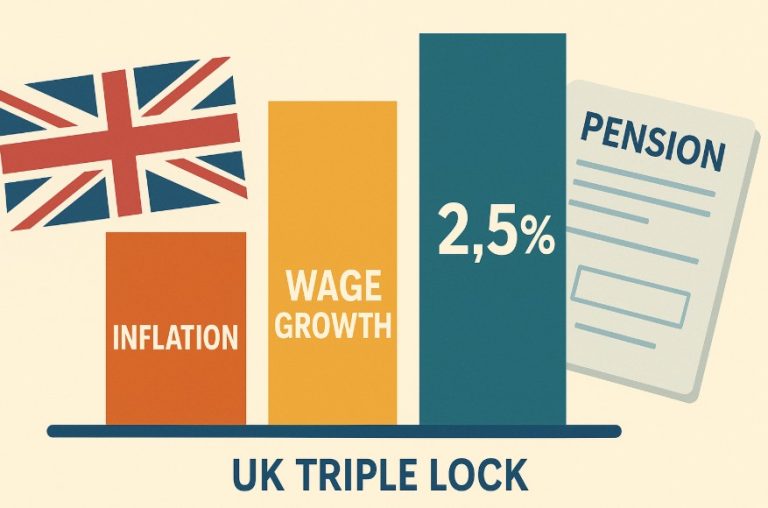The UK State Pension system has undergone several changes over the years, with one of the most significant being the introduction of the new State Pension on 6 April 2016.
One area that still causes confusion is how being contracted out of the State Earnings-Related Pension Scheme (SERPS) or the State Second Pension (S2P) affects your entitlement to the full State Pension.
This article explores how contracting out impacts your State Pension entitlement, what deductions may apply, and what you can do if you were previously contracted out.
What Does It Mean To Be Contracted Out Of SERPS Or The Additional State Pension?

The State Earnings-Related Pension Scheme (SERPS) and its successor, the State Second Pension (S2P), were forms of Additional State Pension offered to employees in the UK. From 1978 until 2016, many employees were given the option to contract out of this system.
Contracting out meant that an individual, along with their employer, paid lower National Insurance contributions.
In exchange, the individual would not build up entitlement to SERPS or S2P during the contracted-out period.
Instead, the reduced contributions were diverted into a workplace or personal pension scheme, with the expectation that this would provide similar or better retirement benefits.
Over time, the government gradually phased out contracting out. It ended for defined contribution schemes in 2012 and was fully abolished for all schemes in 2016 with the introduction of the new State Pension.
This created a significant shift in how State Pensions are calculated, particularly for those with a history of being contracted out.
How Does Contracting Out Affect Your Entitlement To The Full State Pension?
If you were contracted out of SERPS or S2P before April 6, 2016, you may not receive the full new State Pension when you reach retirement age.
This is because your lower National Insurance contributions during the contracted-out period reduced the amount of Additional State Pension you accrued.
To address this, the government uses an adjustment known as the Contracted-Out Pension Equivalent (COPE).
The COPE amount represents the value of the Additional State Pension you gave up in return for your private or workplace pension contributions.
The starting amount for your State Pension on April 6, 2016, was calculated as the higher of:
- The amount you would have received under the old system (Basic + Additional State Pension) minus COPE
- The amount you would receive under the new State Pension rules based on your NI record
If your starting amount was below the full new State Pension, you could build it up by continuing to earn qualifying years after 2016.
Can You Still Get The Full State Pension If You Were Previously Contracted Out?
Yes, it is still possible to receive the full State Pension even if you were contracted out. Whether you achieve this depends on your National Insurance record after 6 April 2016.
Under the new system, each qualifying year you gain after this date adds around 1/35th of the full State Pension to your entitlement.
If you had gaps in your record before 2016 due to contracting out, you can make up the shortfall by working and paying NI contributions or making voluntary contributions.
Key points to consider include:
- Your starting amount in 2016 determines how many more years you need to reach the full State Pension
- You can continue contributing until your State Pension age
- Voluntary Class 3 contributions may help fill gaps if you’re not working
By accumulating additional years after 2016, many people who were previously contracted out can still qualify for the full State Pension.
How Many National Insurance Years Do You Need For The Full State Pension?

To qualify for the full new State Pension, you need 35 years of National Insurance contributions. If you have at least 10 qualifying years, you will receive a proportion of the pension.
Contracted-out years can count towards your total number of qualifying years. However, because you paid reduced contributions during those years, the amount of pension accrued for that period was lower. This is why your starting amount might be below the full amount.
You can increase your pension entitlement by:
- Continuing to work and pay NI contributions
- Receiving NI credits through certain state benefits
- Making voluntary contributions to fill gaps in your record
The following table provides a summary of contribution types and how they affect your pension eligibility:
| Type of Contribution | Counts Toward Qualifying Years | Additional Notes |
| Standard NI from Employment | Yes | Must meet earnings threshold |
| Self-Employed NI | Yes | Class 2 and Class 4 contributions apply |
| Voluntary Class 3 Contributions | Yes | Can be paid to fill historical gaps |
| Benefit-Linked NI Credits | Yes | Examples: Child Benefit, Carer’s Allowance |
| Contracted-Out Years | Yes (partial value) | Reduced rate of contribution affects accrual rate |
It’s essential to check your NI record to identify any shortfalls and consider if topping up makes sense financially.
How Can You Check If You Were Contracted Out And How Much It Affects Your Pension?
If you’re unsure whether you were contracted out of SERPS or the State Second Pension (S2P), it’s crucial to check your records. Many people do not realise they were contracted out, especially if this was done automatically by their employer through a workplace pension scheme.
Contracting out directly impacts your State Pension entitlement, so reviewing your history and understanding the potential deduction is essential for accurate retirement planning.
Checking Your Contracted-Out Status
The most reliable way to check if you were contracted out is through the official State Pension forecast service provided on the GOV.UK website.
This tool shows your estimated State Pension amount at retirement and helps identify whether your entitlement has been reduced due to any periods of contracting out.
To check your status:
- Visit the GOV.UK website and go to the “Check your State Pension” service.
- Log in or register using your Government Gateway account.
- View your pension forecast, which includes:
- Your current estimated weekly State Pension
- The number of qualifying years on your National Insurance (NI) record
- The Contracted-Out Pension Equivalent (COPE) amount, if applicable
If a COPE figure is shown in your forecast, this is a clear indication that you were contracted out at some point in your working life.
Understanding the COPE Amount
The Contracted-Out Pension Equivalent (COPE) is not a deduction from your State Pension in the strictest sense, but rather an estimate of what you might receive from your workplace or personal pension in place of the Additional State Pension you opted out of.
Key points about COPE:
- It is calculated by the Department for Work and Pensions (DWP).
- It reflects the value of the Additional State Pension you gave up by contracting out.
- The government assumes this amount will be covered by your other pension scheme(s).
- Your State Pension starting amount in April 2016 was adjusted to account for this figure.
COPE amounts can vary significantly based on how long you were contracted out and the type of pension scheme you were enrolled in.
Reviewing Your National Insurance Record
Alongside your pension forecast, it’s important to review your National Insurance record. This shows:
- The years for which you have paid or been credited with NI contributions
- Any gaps in your contribution history
- Whether any of your contributions were at a reduced rate due to contracting out
You can access this information through your personal tax account on GOV.UK. Understanding your NI record helps clarify whether you are on track to reach the 35 qualifying years required for the full new State Pension.
Contacting Pension Providers
If you identify a COPE amount in your State Pension forecast, the next step is to review the pension scheme(s) that you were enrolled in during the contracted-out period. These would typically be:
- Employer-sponsored final salary (defined benefit) or career average schemes
- Personal or stakeholder pensions that replaced the Additional State Pension
You should contact the administrators of these schemes to obtain:
- A statement of your expected retirement income from each pension
- Confirmation of the dates you were contracted out
- Information on how your benefits were calculated
If you’re unsure which pensions you were part of, the Pension Tracing Service can help you locate old schemes linked to previous employers.
What To Do If You Find Discrepancies?
If you believe there’s a discrepancy in your pension forecast or NI record such as missing qualifying years or incorrect contracting-out periods you should:
- Contact HMRC to correct your NI record
- Raise a query with the DWP if your COPE amount seems inaccurate
- Speak with your pension provider to clarify any inconsistencies in your workplace pension data
It’s also worth consulting a regulated financial adviser if you need help understanding how your private pension benefits align with your State Pension forecast.
What Should You Do If You Discover A Contracted-Out Deduction?

If your State Pension forecast shows a lower amount due to contracting out, there are several practical steps you can take.
You should first confirm your number of qualifying years and assess whether you can add more years before you reach retirement age.
If you are still working and earning above the lower earnings limit, you will continue to accrue qualifying years automatically.
If you are not working, you may be able to make voluntary Class 3 contributions to fill in any gaps. It’s worth checking how many years you are short of the full pension and calculating the cost of topping up.
You should also:
- Review your private or workplace pension forecast to see what income is expected
- Compare this with your COPE amount to ensure you are compensated for the deduction
- Consult a pensions advisor if your private pension does not seem to fully replace your lost Additional State Pension
Does Your Workplace Or Personal Pension Cover The SERPS Deduction?
When you were contracted out, your NI contributions were reduced, and those savings were expected to fund a workplace or personal pension that would replace the Additional State Pension you gave up.
The government assumes that your private or occupational scheme will provide the equivalent value, although this is not always the case in practice. The effectiveness of this depends on the type of scheme and its performance.
Types of pension schemes typically used during contracting out:
| Pension Scheme Type | Description | Relevance to COPE |
| Defined Benefit Scheme | Pension based on final salary and years of service | Often provides strong replacement value |
| Defined Contribution Scheme | Pension based on contributions and investment returns | Replacement value depends on fund performance |
| Personal Pension Plan | Individually managed retirement savings | Varies widely depending on investment choices |
It is essential to obtain a detailed forecast from your pension provider to assess how your contracted-out pension compares with the expected COPE amount.
Why Does The Government Deduct Pension Amounts For Contracted-Out Years?
The deduction exists because those who were contracted out paid less into the National Insurance system than others. In return, they were expected to receive a similar level of retirement income from their occupational or private pension schemes.
Without the deduction, individuals who contracted out would effectively receive more total pension than those who remained in SERPS or S2P and paid the full NI contributions. This would undermine the fairness of the system.
The deduction:
- Reflects lower contributions during contracted-out periods
- Aligns State Pension entitlements with contributions made
- Helps manage long-term public pension costs
Understanding that COPE is an adjustment based on historical contribution levels is important for managing expectations around your State Pension.
What Are The Most Common Misunderstandings About Contracting Out And The State Pension?
Many individuals struggle to understand the implications of having been contracted out, especially when seeing a lower-than-expected State Pension forecast. Common misconceptions include:
- Assuming the COPE amount is directly subtracted from your pension, when it is actually a reference point for what your private pension should provide
- Believing you are ineligible for the full State Pension because you were contracted out, even though qualifying years post-2016 can help you reach the full amount
- Confusing the starting amount calculation, which takes both the old and new systems into account and chooses the higher of the two
- Not recognising that you can top up your NI record to increase your future pension entitlement
Taking time to understand these points can help individuals make informed decisions about their retirement planning.
How Can You Plan Better For Retirement If You Were Contracted Out?

If you have a history of being contracted out, there are several proactive steps you can take to ensure a secure retirement:
- Regularly check your State Pension forecast to track your progress toward the full pension
- Identify any gaps in your NI record and consider paying voluntary contributions to fill them
- Request pension forecasts from all private or workplace pension schemes you contributed to while contracted out
- Compare your expected workplace pension income with your COPE amount
- Consult with a financial adviser to develop a retirement plan that considers all sources of income
Proper planning, especially if started well before retirement age, can help you address any shortfall caused by contracting out and ensure your retirement income is on track.
Conclusion
Being contracted out of SERPS doesn’t mean you’re destined to receive a reduced pension. While the new State Pension may be adjusted, the system assumes your workplace pension will make up the difference.
If you continue working and making NI contributions or fill any gaps with voluntary payments, you can still receive the full State Pension.
The key is to check your forecast early, understand your COPE amount, and take proactive steps to ensure your retirement income is secure.
FAQs
How do I know if I was contracted out of SERPS?
You can find this information in your State Pension forecast on the GOV.UK website or by contacting your previous employers or pension providers. The COPE amount on your forecast indicates you were contracted out.
What is the COPE amount in my pension forecast?
COPE stands for Contracted-Out Pension Equivalent. It represents the amount the government expects you to receive from your workplace pension instead of the Additional State Pension.
Can I still buy extra years to increase my State Pension?
Yes, if you have gaps in your NI record, you can usually pay voluntary Class 3 contributions to fill those years and increase your pension amount.
Is it worth paying to top up my NI contributions?
It depends on your individual circumstances. If the additional years help you reach the full pension, it can be financially beneficial. Consider speaking to a pensions adviser.
Will my workplace pension definitely cover the COPE deduction?
Not necessarily. While the government assumes it will, the actual amount you receive depends on your scheme’s performance and terms. Always check with your provider.
Can I still get Pension Credit if my State Pension is low due to contracting out?
Yes, if your total retirement income is below a certain threshold, you may be eligible for Pension Credit, which tops up your weekly income.
When did contracting out end in the UK?
Contracting out for defined contribution schemes ended in 2012 and for all schemes in April 2016, when the new State Pension system was introduced.






